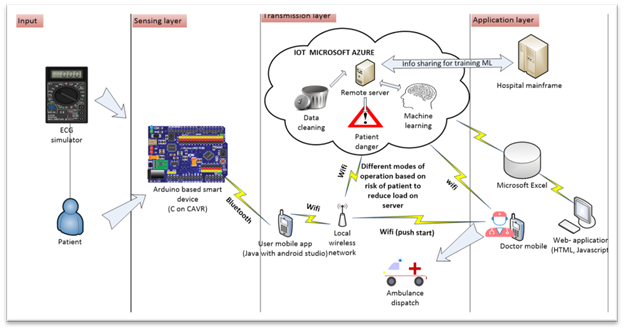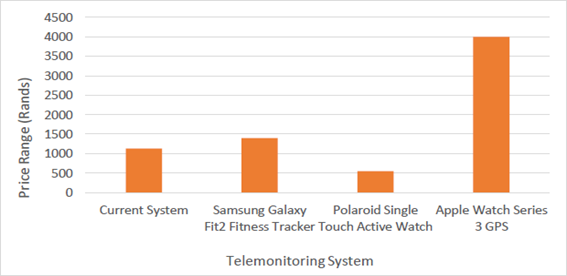





Pragesh Govender, Riaan Stopforth
ORCID ID: 0000-0001-5173-4379, 0000-0002-8878-2232
Stopforth Mechatronics
Robotics and Research Lab
University of KwaZulu-Natal Durban
South Africa
Sudesh Sivarasu
ORCID ID: 0000-0002-0812-568X
Division of Biomedical Engineering
Division of Human Biology
University of Cape Town
Western Cape
South Africa
Elisha Didam Markus
ORCID ID: 0000-0001-6778-4004
Faculty of Engineering
Built Environment and Information Technology
Central University of Technology
Free State
South Africa
Clive Hands
ORCID ID: 0000-0003-2590-6055
Mechanical Engineering Department
Advanced Engineering Design Group
Nelson Mandela University
South Africa
Due to the overburden on healthcare resources, there is a need to invest in Internet of Things (IoT) based telemonitoring devices that can remotely monitor and diagnose patients without constant supervision by health practitioners. Current commercial and research initiatives in this area fail to create a comprehensive IoTbased system with deficits in the sensing layer and model consumption phase being an underlying concern. This gap was closed through the development of an IoT-basedsystem consisting of a multi-faceted wireless body access network (WBAN), cloud integration and two application layers (mobile and web-based). Global Positioning System (GPS) tracking on the patient's phone was used to allow doctors to track and dispense ambulatory services in cases of emergencies. Overall, the developed system was able to possess around 15 of the features common in most wearable health device systems at a reduced cost, thereby successfully achieving the desired outcomes of this research.
Keywords: IoT, telemonitoring
IoT can be defined as an emerging technology which enables devices containing sensors, processors, and communication hardware to connect to the internet by means of a wired or wireless connection (Chandini & Kumar, 2018), (Patel & Salazar, 2016). With nearly two-thirds of the global population expected to have Internet access by the year 2023, the attractiveness of using IoT within an array of industry sectors becomes highly plausible. One such industry which can benefit from the usefulness of IoT is the medical sector, which is expected to have an annual compound growth rate increase of 19% for the period 2019 - 2025 (Grand View Research, 2019). By using telemonitoring systems, patient care can be improved without overburdening health care resources (Christensen, 2018).
Utilising an IoT framework with powerful cloud platforms, predictive modelling, and application layers (mobile and web-based) can assist with health care management of patients (CDC,2020) while also assisting, rather than eliminating, health care professionals (Sarker, 2021). Such a healthcare system will allow for remote monitoring and tracking of patients both in real time and historically, thereby preventing the late detection of communicable and non-communicable diseases (World Health Organization, 2021). This data and tracking can be an invaluable means of proactively managing patients' health conditions before a medical issue escalates (J. Mathew, 2018). Furthermore, according to a WHO report, 46% of the population live in rural areas, yet only 12% of doctors and 19% of nurses work there (World Health Organization, 2010). This indicates a genuine need to utilise such an IoT system for knowledge sharing and bridging the gaps in global healthcare. Since the diagnostic models built within the IoT system will be developed using the intuitive knowledge of experienced doctors as well as a rich information database – rural doctors can stand to benefit from not only better diagnostic tools but also reduced strain because of automatic diagnostics and monitoring. GPRS can be used to facilitate the use of the IoT system within rural areas to replace other more complex protocols such as Wi-Fi, which has not been established in these areas. These simple systems therefore reduce connectivity issues and maintenance costs which are major challenges for technology roll-out in rural areas (Dimitrievski et al., 2021). The transmission of critical patient physiological data directly to caregivers can then be achieved via a mobile application (MA) or web application (WA) interface (G.F. Gensini, 2017).
This research aims to develop such a system which can serve as a fundamental tool within the healthcare sector. Figure 1 displays a high-level overview of the developed system with the MA serving as an IoT gateway (Hulft, 2018). The following contributions will be addressed in this research:

The following material and methods were utilised for the developed IoT system.
i. Materials
The WBAN was developed using various commercial sensors to measure Infrared light, pulse rate, electromyography, electrocardiography, body temperature and humidity. These sensors were read using an Arduino Nano Microcontroller unit (MCU). A 7.4V lithium battery was used with voltage regulators to control the input voltage to the various sensors. Haptic feedback was made possible with a LED and vibration module while short range communication was achieved using a Bluetooth module. A Veroboard was used for creating connections and the electronics were enclosed in a COTS enclosure with a Velcro strap holding the enclosure firmly to the wrist. Figure 2 illustrates this fitting.

The LM35 temperature sensor was utilised for measuring body temperature. The LM35 is low cost (due to wafer-level trimming), compact (20 mm ×5 mm), low energy (<60 μA) and easily accessible with analogue output capabilities. It also operates in the range of -55°C to 50°C which is sufficient for body temperature measurement (EJ Projects, 2021). A HC-06 Module was selected for Bluetooth since it is a common off-the-shelf (COTS) product and can operate in a range of two meters (being a class 2 device) which is sufficient for wearable-to-smartphone communication (etechnophiles, 2022). The Keystudio AD8232 ECG sensor was used for electrocardiography readings due to its low power requirement (170μA) and low supply voltage of 3.3V (Keyestudio, 2021). In addition, the Myoware EMG sensor was chosen for electromyography readings due to its accuracy and because electro pads are placed directly on the sensor which prevents noise in terms of motion artefacts (Sparkfun, 2021). Lastly, the HIH-4000 humidity sensor was used since it required a low voltage supply 4V- 5.8V, had a less than 200μA current requirement, and has a three-layered design to protect against dirt and dust (Honeywell, 2021).
ii. Method
The WBAN was developed by soldering the various sensors onto the Veroboard. Each component was powered by a lithium battery to reduce the strain on the MCU. Voltage reductions were done using voltage regulators. The completed electronics for the WBAN was then placed within the purchased enclosure with holes allowing external components to be placed outside of the enclosure. A Velcro strap was then used to secure the enclosure to the wrist.
The mobile application (MA) was developed using Java on Android Studio. It consisted of two interfaces: one for the doctor and one for the patient. The MA was integrated with Firebase using an application programming interface (API) to allow storage and user authentication during the login and registration. The MCU was programmed using C on CVAVR. The code utilised delimiters to allow for splitting of data on the MA. The MA used broadcast receivers to collect data from the Bluetooth module. The MA was then programmed to split the data and store it on a SQLite database.
A Java database connection (JDBC) was established between the MA and SQL database within the MS Azure Cloud platform. This enabled the transfer of data to the cloud from the patient's phone and subsequent reading of data from the cloud to the doctor's phone. Reading data on the WA was also possible through POST requests using the embedded Javascript template (EJS) engine.
GPS tracking was enabled on the MA using the phone's built-in GPS tracking mechanism. This data was retrieved and uploaded onto Firebase for viewing by health practitioners.
Table 1 shows that the developed IoT telemonitoring system was able to achieve 15 of the typical features present in wearable devices. This included GPS location, interfacing with doctors, and a multi-sensory layer. In terms of sensory inputs, the developed WBAN was able to obtain readings for ECG, EMG, pulse rate, IR, body temperature and humidity while other systems occupied just a few of these sensors. The developed IoT system was also able to consume FL- and ML-based models which many of the systems did not have the capability and infrastructure to do. The developed system was also able to calculate the patient BMI and MEWS rating (an accepted measure of a patient’s health). Another improvement of the current system was the use of two application layers via a WA and MA interface which was not present in any of the compared devices.
Figure 3 shows the developed system was also cost effective considering the array of features at its disposal. The system employed had a price tag of US$70.9 which is considerably lower than most of the devices it was compared to. This takes material costs into consideration, but not manufacturing costs. The addition of best practices and large-scale production could potentially reduce the price further through standardisation, buyer negotiations and outsourcing. The Apple Watch Series 3 was the most expensive at US$251 followed by the Samsung Galaxy Fit 2 and Polaroid at US$87.8 and US$34.5 respectively (Game, 2021). The Polaroid is much cheaper but also has a feature reduction of 40% in comparison to the designed system.


This research was able to successfully deliver an IoT system which enabled remote monitoring of patients by health practitioners. The developed system utilised a wide array of sensory inputs to gauge patient health via the development of predictive ML- and FL-based models. In accordance with the above-mentioned contributions, the following was achieved in this research:
The authors are thankful for the support and sponsorship of MerSETA and MediVentors.
Al-Dmour, J. A., Sagahyroon, A., Al-Ali, A., & Abusnana, S. (2019). A fuzzy logic-based warning system for patients classification. Health Informatics Journal, 25(3), 1004-1024.doi:10.1177/1460458217735674
CDC. (2020, June 10 2020). Using Telehealth to Expand Access to Essential Health Services during the COVID-19 Pandemic. Retrieved from Centers for disease control and prevention:https://www.cdc.gov/coronavirus/2019-ncov/hcp/telehealth.html
Chandini, H. P., & Kumar, M. S. (2018). ECG Telemetry System for IOT Using Rasberry Pi. International Journal of Engineering Research & Technology (IJERT),6(13), 1-4.
Christensen, J. (2018). The Emergence and Unfolding of Telemonitoring Practices in Different Healthcare Organizations. International journal of environmental research and public health, 15(1), 16.doi: 10.3390/ijerph15010061
Dimitrievski , A., Filiposka , S., Francisco , J., Eftim , Z., Petre , L., Pires , I. M.,. . . Trajkovik , V. (2021). Rural Healthcare IoT Architecture Based on Low-Energy LoRa. International Journal of Environmental Research and Public Health, 18(14),7660.doi:10.3390/ijerph18147660
EJ Projects. (2021, 5 9). LM35 Temperature Sensor Pin out, Interfacing guide, Circuit Construction and Working Principals. Retrieved from Engineers Garage:https://www.engineersgarage.com/lm35-description-and- workingprincipal/#:~:text=LM35%20is%20a%20temperature%20sensor,not%20require%20any%20external%20calibration.
eTechnophiles. (2022). HC-06 Pinout, specifications, datasheet and Arduino connection. Retrieved from etechnophiles.com: https://www.etechnophiles.com/hc06-pinout-specifications-datasheet/
G.F. Gensini, C. A. (2017). Value of Telemonitoring and Telemedicine in Heart Failure Management. Cardiac failure review, 3(2), 116-121.doi: 10.15420/cfr.2017:6:2
Game. (2021, November 15). Electronics & Entertainment. Retrieved from Game:https://www.game.co.za/game- za/en/All-Game-Categories/Electronics-%26-Entertainment/c/G002
Grand View Research. (2019). Internet of Things in Healthcare Market Size, Share & Trends Analysis Report By Component (Service, System &amp;amp; Software), By Connectivity Technology (Satellite, Cellular), By End Use (CRO, Hospital & Clinic), By Application, And Segment Forecasts, 2019 - 20. Grand View Research.
Honeywell. (2021). Humidity with temperature sensors.Retrieved from Honeywell:https://www.mouser.co.za/ProductDetail/Honeywell/HIH-4000-004?qs=yJVtgANCw00aQBCIf2C1DQ%3D%3D
Hulft. (2018). IoT Architecture 101. Retrieved September 15, 2021, from https://medium.com/enterprise- strategist/iot-architecture-basics-guide-ff4bcf8e6859
J. Mathew, J. L. (2018). Heart Failure in the Child and Young Adult (illustrated ed.). Elsevier Science. Keyestudio. (2021). Keyestudio.com. Retrieved from Keyestudio AD8232 ECG Measurement Heart MonitorSensor Module for Arduino UNO R3:https://www.keyestudio.com/products/keyestudio-ad8232-ecg-measurement-heartmonitor-sensor-module-for-arduino-uno-r3
Patel, S., & Salazar, C. (2016). Internet of Things-IOT: Definition, Characteristics, Architecture, Enabling Technologies, Application &Future Challenges. IJESC, 6122-6131.doi: 10.4010/2016.1482
Sarker, I. H. (2021). Machine Learning: Algorithms, Real-World Applications and Research Directions. SN computer science, 2(160), 1-28.doi: 10.1007/s42979-021-00592-x
Sparkfun. (2021). MyoWare Muscle Sensor. Retrieved from Sparkfun.com:https://www.sparkfun.com/products/13723
World Health Organization. (2010). Increasing access to health workers. Switzerland: WHO Press.
World Health Organization. (2021). Cardiovascular diseases (CVDs). Retrieved September 13, 2021, from https://www.who.int/news-room/factsheets/detail/cardiovascular-diseases-(cvds)